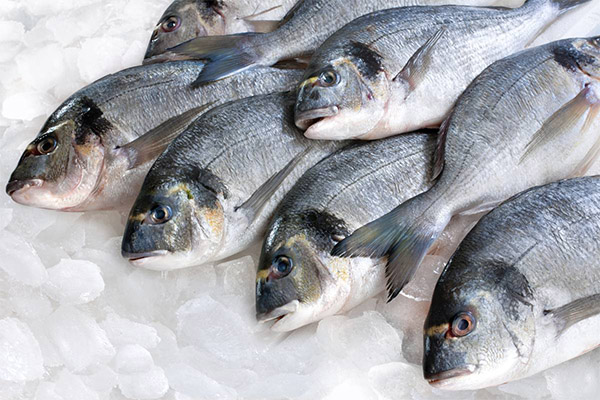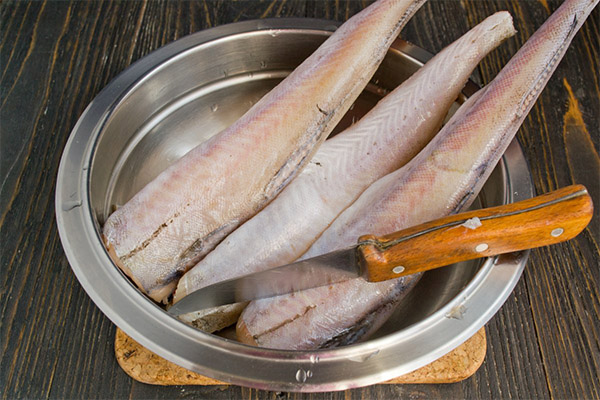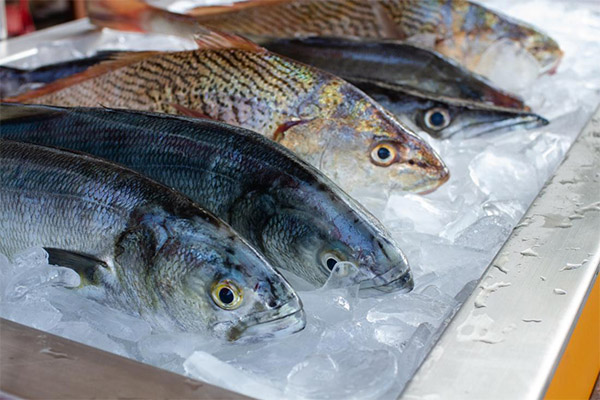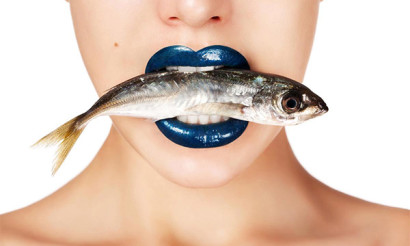How to defrost fish properly and quickly
- Is it possible to fry frozen fish without defrosting
- Is it possible to cook fish without defrosting
- How to defrost fish properly and quickly
- Is it possible to defrost fish
- In water
- In the microwave
- In the oven
- What types of fish thaw in the air
- Is it possible to freeze thawed fish
- How long does it take to defrost a fish
- How much is thawed fish stored in the refrigerator
- How not to defrost fish
It is easier and more beneficial to buy fresh chilled or live fish, rather than frozen, which you will then have to defrost. But this is not always and not accessible to everyone - sales of a number of species of live fish are often seasonal, and chilled almost never happens on the shelves of small cities remote from regional capitals. So you have to choose from what is on sale. Often this “something” is more like a log or stone - the carcass is so densely covered with a layer of ice. Therefore, the mastery’s skill comes to the fore: can she make a delicious dish for this family from this block of ice?
In order not to get into trouble, immediately at the store counter you need to think about and calculate what size carcass you need. It's one thing - if you plan a celebration with an invitation to guests, another is an ordinary family dinner for three to four people. In the first case, you can take larger fish, in the second - either a small individual or steaks, since it will not be possible to cut off excess carcass from a large carcass while it is frozen. Thawed fish cannot be re-frozen.

Proper cooking begins with proper defrosting. And the most suitable way for this is a gradual, slow defrosting. It is better if it is made in the refrigerator, where the negative effect of temperature on tender fish meat will be minimized.
But when there is no time, you can use faster methods - for example, in water or using a microwave, oven or double boiler. If you defrost it according to the rules recommended by experts in the field of cooking or the fish processing industry, the result will not be long in coming: the fish will turn out to be completely edible, moderately juicy and tender.
Is it possible to fry frozen fish without defrosting
Everything happens in life, including this: it's time to cook dinner, and it turns out that the mistress forgot to put the fish out of the freezer so that it thaws. What to do? Do not panic! You will have to get the product and try to quickly make it so that you can put it on the pan. Moreover, only steaks or portioned slices of fillet are suitable for this, since it will not be possible to cut the whole carcass frozen.
It is necessary to expand the fish and hold it a bit under a stream of cool (not cold!) Water, so that the ice crust melts from the surface. Pieces can be washed and, if necessary, cleaned and gutted. Then dry with a paper towel to remove excess moisture to the maximum.
Frozen fish should be sent to a very hot pan. It is enough to roll in flour or breadcrumbs and put on hot vegetable oil. It is important that a dense crust forms quickly. As soon as the underside is well browned, quickly flip over to the other, salt and cover. The lid is obligatory, since it is necessary that the ice lump inside the piece not only melts, but also the flesh has reached the readiness. It will take almost two times more time for this than for preparing previously thawed fish.
In addition, you won’t have to rely on a crisp: the ice will turn into water, the fish will not fry, but languish in boiling liquid. By and large, it’s not fried, but stewed fish. And because of the increased cooking time, the delicate pulp will almost certainly fall apart, there will be less nutrients in the finished product than it could.But in an emergency, if there is nothing more to feed the family, you will have to be content with this option. However, making such a cooking method a habit is not worth it.
With the least loss in quality, fish varieties such as silver hake, saffron cod, horse mackerel or mackerel can be put into the pan in the unfrozen state. They are deformed less than others and better retain nutrients from destruction.
Is it possible to cook fish without defrosting
With cooking unfrozen fish, the conditions are similar: if the situation is stalemate, you have to cook, although this is undesirable. Cooked frozen fish will no longer be tender and as tasty as it could if it had been cooked thawed.
It is necessary to hold a piece under a stream of water to slightly thaw the ice on the surface, and scrape with a knife to remove the remnants of scales and adhered foreign particles: dirt, fragments of the package.
You need to lower such a fish into boiling water: the defrosting process will go faster, and it will boil faster. However, the cooking time will have to be doubled so that the pieces are boiled well until the very middle. And if a soup is planned from fish, you need to prepare that the broth does not turn out to be light and transparent - rather, it will be whitish and cloudy.
How to defrost fish properly and quickly
Which defrosting method is considered the most appropriate depends on several factors: such as the type of fish, the size of the carcass and the method of freezing (carcass, steak or fillet).
So, not very large carcasses of hake or pollock up to one and a half kilograms are best defrosted in cold water. The same fish, but larger - over 1.5 kg, as well as specimens of sturgeon, notothenia, sea bass, silver carp and catfish are better defrosted in air at room temperature. The same conditions are suitable for fillet, briquettes, blocks, minced meat, steaks and gutted fish of the same varieties. This method is fast enough, it can take from one and a half to three hours.
For salted fish - such as pollock, salmon, pike, carp, pikeperch and trout - thawing in salt water is good. Moreover, one should not keep it in water until fully prepared: after an hour's stay in a basin with liquid, fish should be removed and left at room temperature to finally thaw. A salt solution is prepared at the rate of 25 grams of salt (it is better to take a large stone) for 1.2 liters of water.
Smoked fish can be kept in the refrigerator for five hours, then taken out and left at room temperature until cooked.
It is permissible to use salt for defrosting fish not only in the form of a solution, but also in a dry form. If you remember how windshield wipers sprinkle salt on asphalt in winter so that the ice melts on it, it becomes clear: salt is what you need in the fight to defrost a product. Each frozen fish is salted on both sides and waiting for it to thaw.
But the best way for absolutely all types of fish is defrosting in the refrigerator, the temperature there should be +5 degrees. Thus, it is possible to achieve slow thawing without causing any harm to the quality of the product. Before you put it in the refrigerator, you need to puncture in several places a dense plastic packaging. If the fish is unpacked, it is worth wrapping it in cling film. Place a plate or bowl with carcass on the lower shelf for about 7–9 hours. When the fish thaws, remove the packaging or film, pour out the released liquid, and dry the carcass with paper towels or a towel.
If you need to defrost a fish as quickly as possible, they usually use kitchen electrical appliances, such as a microwave. But some particularly inventive housewives use seemingly completely exotic methods for this - for example, thaw a carcass with a hairdryer. And, oddly enough, this fun method works.
But first, the fish removed from the freezer for half an hour must be removed in the refrigerator - the taste will be better preserved. Then wrap it in cling film, put it in a plastic bag and turn on the hairdryer in cold air mode, without starting heating.Direct the cold air stream at medium speed directly into the bag, keeping the appliance at a distance of about 20 cm from the fish. The cling film protects the carcass surface from weathering and drying. To speed up the process, you can draw several times with an air stream over the package along the entire body of the fish. If the hair dryer has already warmed up, you need to arrange a break for it in a few minutes. The whole defrosting process will take no more than 40–45 minutes.
The fish thawed with a hair dryer should be rinsed, dampen the moisture with a paper towel and immediately proceed with its further preparation.
There are many housewives who successfully defrost fish in a slow cooker, for which they set the minimum heating program for 15–20 minutes. They also put the product on the upper pan of the double boiler for the same time. True, this method is only suitable if it is then planned to cook fish, but not fry and salt. Although you can directly in a double boiler or slow cooker, immediately after defrosting, bring it to readiness.
To do this, hold the frozen carcass slightly under running water, so that it thaws a little on top, scrape off any adhering dirt with a knife, and rinse again. Then put a double boiler on the grate for thawing, and after 20 minutes put into cooking mode, increasing the temperature. A dish prepared in this way may seem empty due to a not very pronounced taste, so the fish should not only be salted, but also sprinkled with lemon juice and sprinkle on it. After 5 minutes, the whole house will be filled with a surprisingly mouth-watering smell.
Another defrosting method is very similar in principle with a double boiler, when you need to install a colander in a pot of boiling water in which to put a bowl with fish fillet. With a little drilling, it is necessary to keep the product in a bowl, turning the pieces from time to time to defrost evenly. Usually after about 12-15 minutes, the fire under the pan can be turned off because the fish has thawed.
Is it possible to defrost fish
In water
To defrost a product in water, you need to put it in bags made of polyethylene: first in one, which is tightly tied, then in the second - and again tied, and so on. It is important to pack the fish carcass so that the liquid cannot leak into the cocoon from the bags. If the fish turns out to be unprotected in the water, it will absorb the liquid into itself and become watery, tasteless.

You can proceed in two ways.
The first way is to defrost under running water until the product is completely thawed, it will take about an hour and a half. Water must always be cold, because the warm or hot flesh will become loose, flabby and tasteless, and nutrients and vitamins will be destroyed.
A lot of water will flow for an hour and a half, which will be ruinous for those who have water meters. The second method is more suitable for them: pour cold water into the basin and put a bag of fish in it. Every half hour, you need to drain the water and fill in a new one until the carcass freezes. A fish weighing about a kilogram will require a couple of hours, a larger one - up to two kilograms - will be ready in three hours.
In the same way, not only the whole carcass can be thawed, but also minced fish and fillets. Professional chefs and nutritionists consider defrosting fish in water as the safest and fastest way, which allows you to preserve nutrients and vitamins, and not spoil the density of the meat and its taste.
In the microwave
Thawing fish in a microwave oven (or in a microwave oven) is not difficult, unless, of course, the carcass fits there. To defrost, you will need a sufficiently spacious glass, ceramic or plastic dish, designed specifically for the microwave. You need to put fish in it, put the container in the oven and turn on the “Defrost” mode. And today, many modern microwave ovens have a separate function "Defrosting fish", the hostess only needs to dial the weight of the carcass on the display. And that’s all! Then the process will go on its own, you can only once or twice check in what condition the product is.If you turn it over during thawing, the fish will reach the desired condition faster and the skin will not dry out.
In total, the fish can thaw in the range from 15 minutes to half an hour, taking this into account, you need to set the time: first 5-7 minutes, and when the microwave goes off, open the door, turn the carcass and drain the water from the container in which it lies, then continue the defrosting process. It is important not to miss the moment when the product is already thawing, but still not too soft.
Thawing of fish takes place due to the influence of ultra-high frequency waves, and they are sparingly useful substances contained in the fish pulp. But the taste of fish from the microwave will turn out worse than that of defrosted fish in the refrigerator: its meat will become drier due to the fact that part of the moisture evaporates. In addition, some people note that after a microwave, the fish developed a slight but specific aftertaste. Therefore, you need to use the microwave for defrosting occasionally and only in emergency cases.
However, if you still had to use a microwave oven, there is a little secret: in order to return tenderness, softness and juiciness to the fish, after defrosting it must be dipped in milk for a quarter of an hour.
In the oven
If the stove is modern, then in the oven there are usually convection or defrost modes. It is they who must be used, proceeding with the preparation of the aquatic inhabitant.
The defrost function is built into electric ovens and is indicated by a drop with a snowflake above it. When this function is activated, only the fan is turned on, the heating elements do not work, so defrosting occurs only due to the fact that air flows around the fish. They "drive off" the chilled ice air, which envelops the carcass like a cloud, and replace it with warm. The temperature does not rise, it remains room temperature, but still the thawing of the product is faster, and its appearance and nutrients are well preserved.
Even faster, the fish will unfreeze if you turn on the heating, but the temperature should not be higher than 30 degrees.
If there is no defrost function, you can use the convection mode at a temperature of 0 degrees.
But if the stove is ordinary, and it does not have these functions, you can still use the oven to defrost the fish. To do this, heat the oven to 30 degrees and turn off the heat. Put the fish removed from the packaging on a plate and send it into the oven on the grill. So she thaws faster.
There are general recommendations for defrosting in the oven, which are suitable both for an ultramodern unit with the functions of defrosting and convection, and for a simple "grandmother" stove. Firstly, the grate, on which the plate with fish will be placed, must be set to the lowest possible level. Secondly, do not use glassware. Thirdly, it is not necessary to cover the fish in the oven - neither a lid, nor foil, nor film.
What types of fish thaw in the air
Both professional chefs and technologists working in the fish processing industry recommend defrosting various types of sturgeon, catfish, hake, nototeniya, blue whiting, sea bass, saber, icefish, pollock, silver carp and macrus - that is, carcasses of medium and large sizes . In addition, the list includes steaks, minced meat, blocks and briquettes of fillet.
The fish is not laid out tightly, but at some distance from each other, so that the carcasses or blocks do not touch each other, and cover with plastic bags or cling film. The defrosting process can last from 5 to 9 hours - depending on the size of the carcass.
Occasionally, it is necessary to look under the film and, if the fillet is thawed, break off the outer, already thawed plates of the pulp.
When a fish is thawed in air, its weight decreases on average by 10%, since juice flows from the meat. In addition, minimal evaporation of moisture from the surface and drying of the carcass is possible. At the same time, this method of thawing is gentle, thanks to it most of the nutrients, minerals and vitamins are preserved in the pulp.However, in hot weather, this method of thawing can be dangerous due to the fact that various bacteria, including pathogens, begin to develop in the product with great speed.
Is it possible to freeze thawed fish
Sometimes it happens that the fish thawed for dinner is too much. The hostess fried her huge frying pan, but there was still a decent amount of pieces. Put it back in the freezer? No, you can’t do this because it, re-frozen, during the next defrosting will become a shapeless gruel-like mass, tasteless and with a not very pleasant smell. The fact is that, in essence, the flesh of a fish is a plate, very weakly bonded to each other, and these bonds are easily broken by a sharp temperature difference. When water crystallizes during freezing, the tissues quickly and simply break. Hence the isolation of fish juice from the pulp, and its deformation.

However, here there are some nuances. The integrity of the fish carcass during freezing also depends on the breed of the inhabitant of the reservoirs. For example, tender trout meat will suffer more, and rough and harsh, like pollock, less. Moreover, re-frozen pollock becomes even tougher, coarser and very similar in texture to rubber. However, if you plan to make fish cakes and roll the flesh in a meat grinder, it does not matter if the fish is frozen once or twice.
In addition, during thawing on the surface of the carcass, the life of various microorganisms was already born, which probably began their dirty work of spoiling the product. That is, re-frozen fish can be simply harmful or even dangerous to health.
What to do with the remaining and unclaimed fish? You can boil it, disassemble it from the bones and divide it into small pieces. Separately in a pan, stew with vegetable oil onions, carrots and tomatoes, adding salt and spices to vegetables. Put the fish at the bottom of the salad bowl, put the stewed vegetables on top, cool and put in the refrigerator until morning. Tomorrow will be a wonderful cold dish - fish under the marinade, which is good both on its own and as an appetizer.
And you can separate the flesh from the bones, pass through a meat grinder, adding onions and garlic. And this minced meat is quite realistic to put in the freezer. But it is better to salt it, add the egg and spices, form cutlets, putting a small piece of butter inside each one. Roll the patties in breadcrumbs (if they are absent, the usual flour will do) and fry until browned on both sides. A hearty breakfast is ready! In the morning, it remains only to warm up (and there are also lovers of cold fish cutlets). These cutlets are much healthier than a traditional morning sausage sandwich. In extreme cases, ready-made cutlets can be removed into the freezer, and they will quite calmly wait in the wings.
But best of all, to avoid the hassle of urgent processing of surpluses, it is necessary to carefully and more accurately assess the need for a product for lunch or dinner and thaw exactly the amount of fish that is needed.
How long does it take to defrost a fish
So, the hostess decided that for dinner she would cook fried fish. And since she knows that the most appropriate method of defrosting is slow, then, leaving for work, she will take out a carcass from the freezer and put it on the lower shelf of the refrigerator. By the evening, when she returns home, the fish will be ready for further cooking.
Thawing a fish weighing about a kilogram in this way will take from 7 to 9-10 hours, a two-kilogram fish can thaw much longer - almost a day! But even if the carcass has thawed a little bit to the end, this will not be an obstacle: this fact will not hinder cleaning the product, and some species are even more convenient to process a little frostbitten.
Waiting for guests and wanting to surprise them with a delicious dish, you can defrost fish only slowly - in the refrigerator. All other methods degrade its structure, appearance, color and taste, and even the greatest culinary talent will not save the reputation of the hostess who prepared a dish from quickly thawed fish carcasses.
You can leave the fish to defrost simply in the air. In this case, it is important that it is in a plastic bag, which will protect its surface from drying out. If the kitchen is 20–22 degrees, then the carcass will thaw in about 6 hours, and the steak - even faster, in four hours. But such defrosting is dangerous: in the warmth in fish meat, microorganisms multiply rapidly, it begins to deteriorate and even rot.
Defrosting a fish in a basin of cold water, where it is placed in several plastic bags, can proceed faster - up to three hours. Sometimes it is sent to the refrigerator directly in bags and water. This option is possible, but somewhat meaningless: the defrosting time remains the same as in the case when the carcass is simply put in the refrigerator, without water. In addition, we should not forget that the water in the basin should be changed several times during a defrosting session.
Even faster - in an hour and a half - you can defrost the fish under a stream of cold running water. An hour and a half will be enough for this, but this method is suitable only for those who are not used to counting the water flow.
Quickly enough - up to two hours - a medium-sized carcass is thawed in saline. But it is recommended to use this method only for preparing sea fish, the body of which is saturated with its own salts and does not particularly react to the fact that the salt solution draws liquid from the fish meat, which makes it dry and harsh. For freshwater, salt water is fatal. But it is quite acceptable for oily fish, which is supposed to marinate, stew, fry, smoke or bake.
In salt water, only whole fish can be thawed; for steaks and cut carcasses, this method is not suitable.
In such a solution, it is equally acceptable to hold the fish both simply on the kitchen table, where the process will go quickly, and put it in the refrigerator, where the defrosting will take a little longer and may take four instead of two hours.
Using even faster defrosting methods, you can bring the fish to their condition in just 40 minutes. A hairdryer with a stream of cold air can do this. A slow cooker, a double boiler, an oven or a water bath will help you complete this task in 15–20 minutes. But here it is important not to overexpose the carcass and not to defrost longer than this time, otherwise the fish will become too soft, loose, begin to fall apart - to the point that it cannot be cut with a knife, since the flesh will simply wrinkle. And there are almost no useful substances left in it.
How much is thawed fish stored in the refrigerator
Thawed fish, which has lain for a certain time on the shelf of the refrigerator, is not the best product for the table. It is better to create culinary masterpieces from it immediately after thawing. But since force majeure happens in life, it also happens that the planned cooking of fish for lunch has to be postponed. However, putting off for more than two hours is highly undesirable. Staying fish will be tasteless, and the meat will lose its shape, become loose.

In this case, before putting the carcass in the refrigerator for temporary storage, you need to remove it in a container of food plastic or glass and tightly close the lid. If all containers are occupied, wrap in wet cotton cloth.
Moreover, the fillet is not subject to storage at all - even short-term. Prepare a dish from it immediately after defrosting.
How not to defrost fish
So that the fish does not lose its taste, does not fade in appearance and does not harm health, you should never thaw it in hot or warm water. And cold water will be useless if you put fish in it without a bag, just a carcass.The liquid will draw a number of vitamins and minerals from the fish pulp, which means that the product will lose a significant part of its nutritional value.
In addition, putting the carcass or steak on thawing in air, it is necessary to cover them with a lid and do not defrost completely (to a too soft state). It is better to let them inside be a little frostbitten when the hostess begins to prepare any dish from it. This applies primarily to fillets.
Minced meat or fish semi-finished products - for example, meatballs or meatballs - cannot be thawed in a water bath, as they will become shapeless and tasteless, they will lose juice and aroma. For them, it is best to thaw in the refrigerator, on the bottom shelf.
«Important: all information on the site is provided exclusively in fact-finding purposes. Before applying any recommendations, consult with a profile specialist. Neither the editors nor the authors are liable for any possible harm caused materials. "















